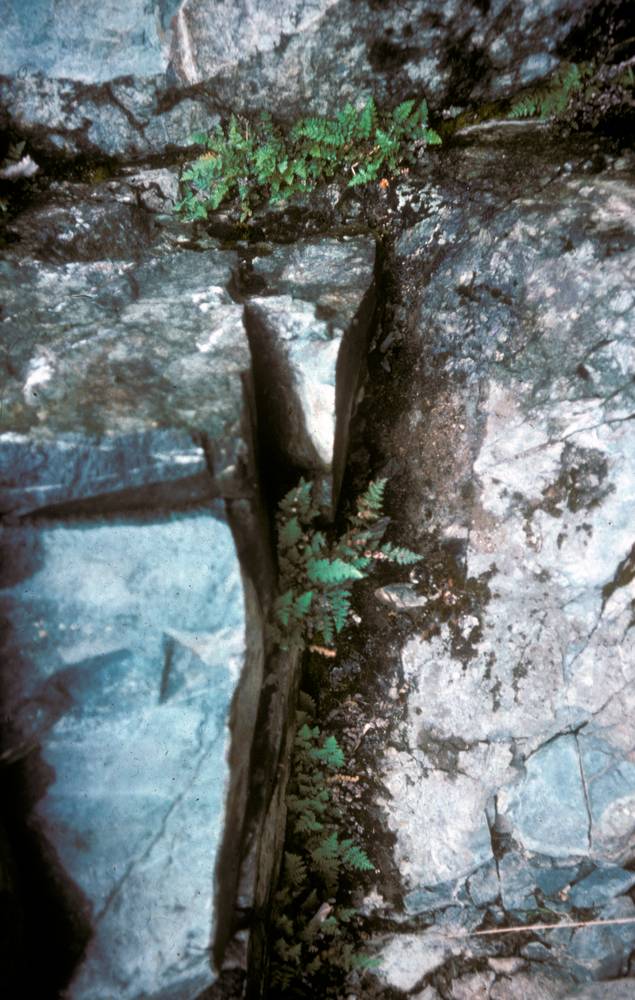
[Originally published in Flora of Oregon as Cheilanthes feei.]
Stems ascending or shortly creeping in rock crevices, much-branched and forming a caudex; scales narrow, dense and persistent, some monochromatic brown, mostly bicolored with a well-defined dark central stripe and pale, scarious margins, some entirely pale brown.
Leaves short, up to 20 cm, produced in clusters from the caudex, circinate when young.
Petioles slender, up to about half of the leaf length, dark brown, with basal scales, pubescent with long, more or less spreading, brownish, multicellular hairs; indumentum and appearance of rachis similar to the petiole.
Blades lanceolate to 12 × 3 cm, 3(4)-pinnate, scaleless, widest near the base; lowest pinnae not or slightly shorter; distal half of blade with pinnae gradually reduced in length apically.
Ultimate segments rounded, convex, mid-green, and bead-like adaxially, concave and red-brown abaxially with the leaf margin recurved but not or hardly covering the widely dispersed sporangia; abaxial indumentum very dense, of long, red-brown, tangled hairs that spread beyond the lobe margins, hairs sparse to absent adaxially.
Sporangia submarginal, often covering the underside of the leaf segment except for the midrib area.
2n=90 (apogamous triploid).
Cliffs, rocky areas, basalt or limestone. 300–900 m. BW. CA, ID, NV, WA; north to British Columbia, east to WI and TX, south to northern Mexico. Native.
as described under Cheilanthes feei
Stems compact to short-creeping, usually 4--8 mm diam.; scales often uniformly brown but at least some on each plant with well-defined, dark, central stripe, linear-lanceolate, slightly contorted, loosely appressed, persistent. Leaves clustered, 4--20 cm; vernation circinate. Petiole dark brown to black, rounded adaxially. Blade linear-oblong to lanceolate, 3-pinnate at base, 1--3 cm wide; rachis rounded adaxially, lacking scales, with dense monomorphic pubescence. Pinnae not articulate, dark color of stalk continuing into pinna base, basal pair usually smaller than adjacent pair, ± equilateral, appearing sparsely pubescent to glabrescent adaxially. Costae brown adaxially for most of length; abaxial scales absent. Ultimate segments round to slightly oblong, beadlike, the largest 1--3 mm, abaxially densely villous with long, segmented hairs, adaxially sparsely hirsute to glabrescent. False indusia marginal, weakly differentiated, 0.05--0.20 mm wide. Sori ± continuous around segment margins. Sporangia containing 32 spores. n = 2 n = 90, apogamous.Sporulating late spring--fall. Calcareous cliffs and ledges, usually on limestone or sandstone; 100--3800 m; Alta., B.C.; Ariz., Ark., Calif., Colo., Idaho, Ill., Iowa, Kans., Ky., Minn., Mo., Mont., Nebr., Nev., N.Mex., Okla., Oreg., S.Dak., Tex., Utah, Va., Wash., Wis., Wyo.; n Mexico.Cheilanthes feei is an apogamous triploid of unknown parentage. It has small, beadlike blade segments similar to those of subg. Physapteris , but most morphological characteristics suggest a clear relationship to members of subg. Cheilanthes (T. Reeves 1979). The species is most often confused with C . parryi , from which it can be distinguished by its thinner, sparser pubescence and smaller ultimate segments.